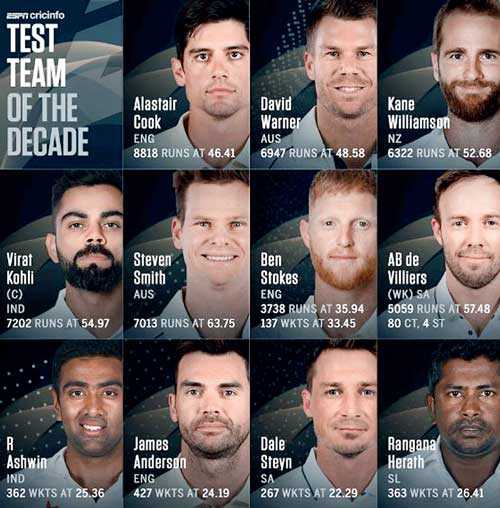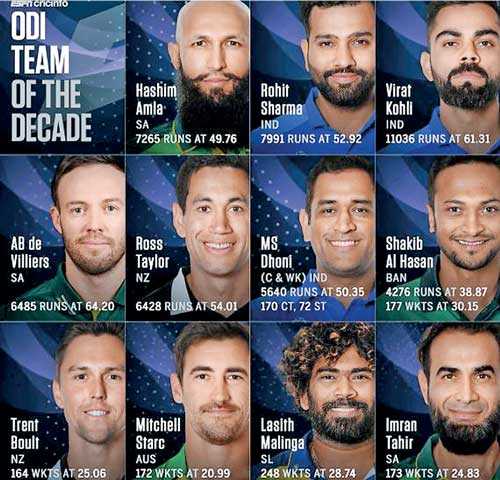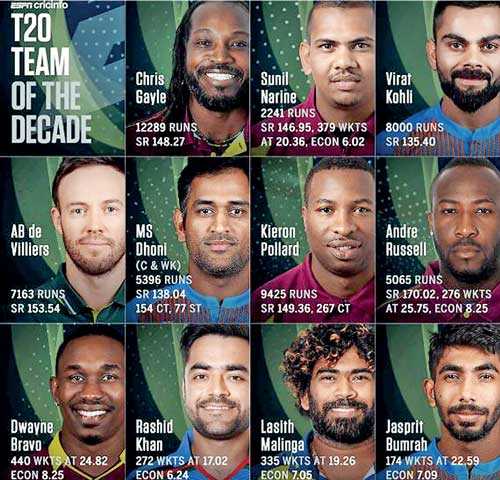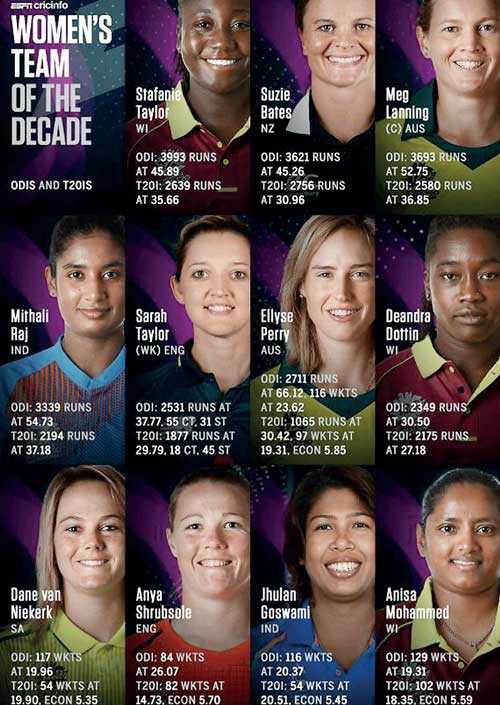Thursday Jan 23, 2025
Thursday Jan 23, 2025
Thursday, 2 January 2020 01:09 - - {{hitsCtrl.values.hits}}
Picking XIs for a decade can feel a bit like trying to form Powerplay rules – introducing artificial restrictions to drum up some excitement – because cricket careers and schedules don’t naturally lend themselves to decade-style reviews. But ESPNcricinfo’s staff were not going to pass up an opportunity to make use of their endless cricket watching to play selectors. Let the arguments begin.
Test cricket evolved markedly in the 2010s, as evidenced by our opening partnership: a marriage of old-school defence and T20-inspired stroke-making. Only one member of our 23-member panel didn’t pick Alastair Cook, who led the run-scoring charts for the decade with 8,818 at 46.41*. His partner, David Warner, was another shoo-in after his gradual evolution from a flashy upstart to one of the format’s top players. 
Three of the so-called Fab Four slot in below. Joe Root’s relatively poor run since he took up England’s captaincy meant he failed to get a single vote. As the outstanding batsmen of their generation, there can be no surprise that Kane Williamson, Virat Kohli and Steven Smith boost the middle order with their 74 Test hundreds in this decade. Ben Stokes slots in at number six, having become the world’s premier all-rounder.
The Adam Gilchrist effect left the 2010s without an obvious candidate to keep wicket – though B.J. Watling was unfortunate to miss out. A.B. de Villiers’ ability to go relentlessly hard or produce rear guards like he did in Adelaide in 2012 means he gets the gig behind the stumps.
Dale Steyn was a unanimous choice. His wicket-taking ability is evidenced by a strike rate of 43.9 for the decade. He will share the new ball with James Anderson, the leading wicket-taker for the period. With another few years’ experience, Jasprit Bumrah might well have been a contender, but he fell way short of the criteria for this XI of a minimum of 50 Tests or six active years (75 ODIs/100 T20s were the criteria for the men’s limited-over teams). 
Nobody took as many five-wicket hauls in the decade as the legendary Rangana Herath, who shares spin duties with the man responsible for much of India’s success at home – R. Ashwin.
With three different World Cup winners in the decade, it is no surprise that as many as six different countries are represented in our ODI XI. Hashim Amla and Rohit Sharma open the batting as the format’s second- and third-most prolific run scorers in the decade, while 50-over cricket’s GOAT, Virat Kohli, slots in at three.
de Villiers, whose strike rate in the 2010s was a sublime 109.76, played the decade’s defining innings in 2015, when he made a 44-ball 149 – the fastest ODI hundred – against West Indies at the Wanderers. He was a single vote away from joining Sharma and Kohli as a unanimous pick.
Ross Taylor edges out Jos Buttler, thanks to his longevity and an eye-catching average of 54.01, while MS Dhoni slots in as captain and wicketkeeper – though his powers might have waned towards the end of the decade, he remains the great thinker of modern limited-overs cricket, and averages over 50 in the 2010s. 
Shakib Al Hasan is the side’s allrounder, having spent the decade giving Bangladesh not only runs and wickets but control and balance thanks to his multifarious talents; Imran Tahir, the leading legspinner in the format in the 2010s, takes the other spin role.
The pace attack is a mouth-watering combination of Trent Boult, Mitchell Starc and Lasith Malinga, the three outstanding seamers of the given period – good luck telling one of those three they won’t be taking the new ball.
Our short-form XI is dominated by West Indians – hardly a surprise given their World T20 wins in 2012 and 2016 and their prominence across the domestic leagues of the world. Two of them combine to open the batting: Chris Gayle, the format’s all-time leading run scorer and its first global icon was an automatic pick. Sunil Narine, whose pinch-hitting exploits have redefined T20 hitting, joins Gayle up top while also earning his spot thanks to a superb decade as a mystery spinner.
Kohli and de Villiers complete their clean sweeps in our men’s sides at number three and number four respectively. And Dhoni’s tactical nous, glove work and batting make him an irresistible package in he middle order. Three West Indian all-rounders comprise the lower middle order. Kieron Pollard, the first true big-name T20 freelancer, is followed by Andre Russell, the 2019 IPL MVP and the man who is single-handedly pushing the boundaries of possibility for batsmen around the world. Dwayne Bravo, a star not just for Chennai Super Kings but around the world, slots in at number eight.
Afghan sensation Rashid Khan joins Narine as the other main spin option, while there is a distinctive Mumbai Indians feel to the other two seamers, Malinga and Bumrah, the two best yorker bowlers of the decade. 
Our women’s XI is packed with all-round options and some of the game’s most iconic players – though there are high-profile omissions in Megan Schutt, Alyssa Healy and Smriti Mandhana.
The batting line-up combines clean hitting with calm accumulation. The top three are the decade’s leading run scorers in both ODIs and T20Is (the two formats under consideration): Stafanie Taylor, Suzie Bates and the captain, Meg Lanning. Indian great Mithali Raj, another shoo-in, averaged 55.31 in ODIs and 37.18 in T20Is in the decade.
Sarah Taylor, the outstanding wicketkeeper of the era, comes in at number five. Australian superstar Ellyse Perry and West Indies legend Deandra Dottin complete the middle order. Perhaps unsurprisingly, given they formed the backbone of Australia’s all-conquering side during the decade, Perry and Lanning were the two unanimous choices in the side. Among the specialist bowlers, the leading women’s ODI wicket-taker of all time, Jhulan Goswami, edged out Shabnim Ismail to share the new ball with England stalwart Anya Shrubsole, while the decade’s standout bowler, Trinidadian offie Anisa Mohammed, and South African allrounder Dane van Niekerk will lead the spin attack.